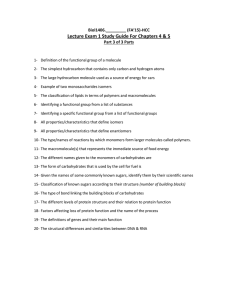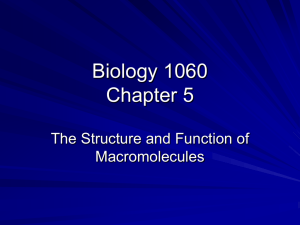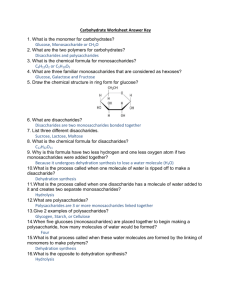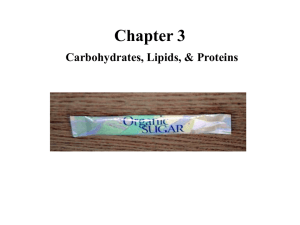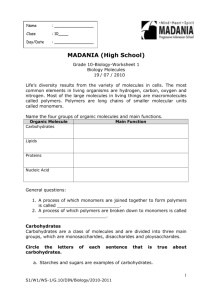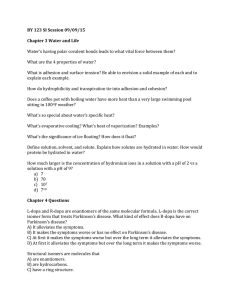Molecules of Life I CHAPTER 3 Carbon/Organic Chemistry Carbohydrates
advertisement
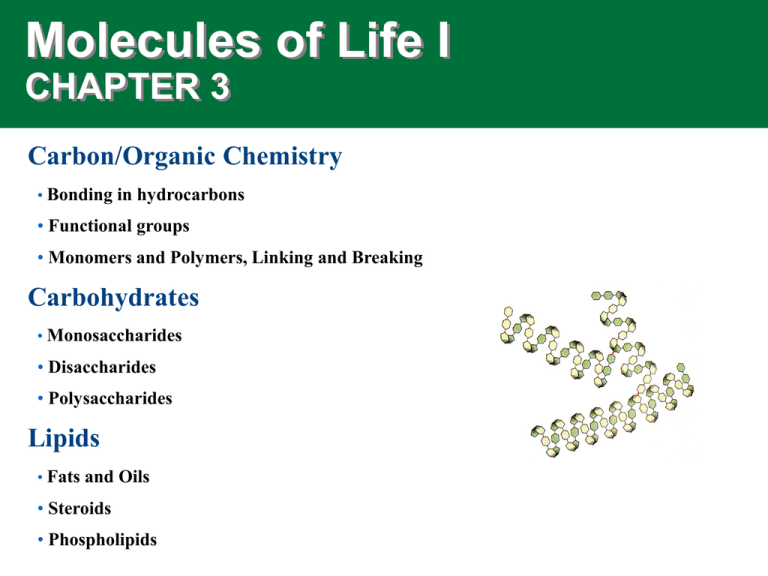
Molecules of Life I CHAPTER 3 Carbon/Organic Chemistry • Bonding in hydrocarbons • Functional groups • Monomers and Polymers, Linking and Breaking Carbohydrates • Monosaccharides • Disaccharides • Polysaccharides Lipids • Fats and Oils • Steroids • Phospholipids Relevance of Biomolecules in Everyday Life completely Organic Molecules • • • A cell is mostly water. – The rest of the cell consists mostly of carbon-based molecules. – Organic chemistry is the study of carbon compounds. Carbon is a versatile atom. – It has four electrons in an outer shell that holds eight. – Carbon can share its electrons with other atoms to form up to four covalent bonds. Carbon can use its bonds to: – Attach to other carbons. – Form an endless diversity of carbon skeletons. Each Carbon Atom Makes Four Covalent Bonds to Other Atoms Figure 3.2 Carbon Connects With Hydrogens to Form Hydrocarbons Methane (CH4) is the simplest hydrocarbon Figure 3.3 Other Hydrocarbons in Our Lives Figure 3.4 Molecules of Life I CHAPTER 3 Carbon/Organic Chemistry • Bonding in hydrocarbons • Functional groups • Monomers and Polymers, Linking and Breaking Carbohydrates • Monosaccharides • Disaccharides • Polysaccharides Lipids • Fats and Oils • Steroids • Phospholipids Structure Gives Rise to Function • Each type of organic molecule has a unique threedimensional shape that defines its function in an organism. – The molecules of your body recognize one another based on their shapes. – Even slight differences in molecular arrangement effects the chemical behavior of a molecule – Certain groups of atoms confer chemical reactivity to a molecule (functional groups) Isomers Functional Groups That Contribute to Molecular Behavior Figure 3.5 Molecules of Life I CHAPTER 3 Carbon/Organic Chemistry • Bonding in hydrocarbons • Functional groups • Monomers and Polymers, Linking and Breaking Carbohydrates • Monosaccharides • Disaccharides • Polysaccharides Lipids • Fats and Oils • Steroids • Phospholipids Giant Molecules from Smaller Building Blocks • On a molecular scale, many of life’s molecules are gigantic. – Biologists call them macromolecules. – Examples: DNA, carbohydrates • Most macromolecules are polymers. – Polymers are made by stringing together many smaller molecules called monomers. – Cells link monomers by dehydration reactions. monomers polymer Dehydration/Condensation Synthesis of a Polymer Figure 3.6a Hydrolytic Breakdown of a Polymer Figure 3.6b Biological Molecules • There are four categories of large molecules in cells: – Carbohydrates – Lipids – Proteins – Nucleic acids Molecules of Life I CHAPTER 3 Carbon/Organic Chemistry • Bonding in hydrocarbons • Functional groups • Monomers and Polymers, Linking and Breaking Carbohydrates • Monosaccharides • Disaccharides • Polysaccharides Lipids • Fats and Oils • Steroids • Phospholipids Carbohydrates • Carbohydrates are composed of: – Simple sugars (monosaccharides) found in table sugar, fruit, and soft drinks. – Complex sugars (polysaccharides) found in pasta and potatoes as well as the cells of plants Simple Sugars: Monosaccharides • Monosaccharides are simple sugars. – Glucose is found in sports drinks. – Fructose is found in fruit. • Honey contains both glucose and fructose. Glucose and Fructose are Structural Isomers Hydroxyl groups make these sugars polar and water soluble Carbonyl functional groups makes these sugars reactive (can lose electrons) Same molecular formula but different structural formulas Simple Sugars Usually “Round up” into Rings Glucose Fructose Straight chain form Ring form Disaccharides • A disaccharide is a double sugar. – It is constructed from two monosaccharides. • Disaccharides are joined through a dehydration reaction. Disaccharides Lactose is a disaccharide that some people cannot digest as adults Figure 3.11 Table Sugar (Sucrose) is a Disaccharide Polysaccharides • Complex carbohydrates are called polysaccharides. – They are long chains of sugar units. – They are polymers of monosaccharides. • Polysaccharides can be classified by function – Energy storage polysaccharides – Structural support polysaccharides Polysaccharides Three Polysaccharides Energy storage Energy storage Structural support in plants Figure 3.13 Cellulose Cannot Be Broken into Glucose Monosaccharides By Mammals Plant-eaters have resident bacteria and protozoa that break the cellulose into glucose within their digestive system Molecules of Life I CHAPTER 3 Carbon/Organic Chemistry • Bonding in hydrocarbons • Functional groups • Monomers and Polymers, Linking and Breaking Carbohydrates • Monosaccharides • Disaccharides • Polysaccharides Lipids • Fats and Oils • Steroids • Phospholipids Lipids • Lipids are not water soluble (hydrophobic) – Lipids are mostly composed of hydrocarbon chains or rings – They do not mix with water. • Important lipid polymers that we will study are: – Fats and Oils – Phospholipids – Steroids Fats and Oils (Triglycerides) • Fats perform essential functions in the human body: – Energy storage – Cushioning – Insulation • A fat or oil consists of a four part chain of hydrocarbons (a triglyceride) – Triglyceride is a combination of glycerol and three fatty acids. A Fat or Oil is Made From Three Fatty Acids and One Glycerol Dehydration reactions Fats Saturated and Unsaturated Fats (Triglycerides) • • Unsaturated fatty acids (One or more C=C bonds) – Have less than the maximum number of hydrogens bonded to the carbons. – Tend to be solid at room temperature, e.g.. butter Saturated fatty acids (Only C-C bonds) – Have the maximum number of hydrogens bonded to the carbons. – Tend to be liquid at room temperature, e.g. corn oil Healthy Triglycerides • Not all fats are unhealthy. – Some fats perform important functions in the body and are essential to a healthy diet. – Many unsaturated fats and cis-fats are good for you Steroids • Steroids are very different from fats in structure and function. – The carbon skeleton is bent to form four fused rings. • Cholesterol is the “base steroid” from which your body produces other steroids. – Example: sex hormones Steroids Consist of Four Joined Rings Biological role: Helps keep cell wrappers (membranes) fluid and flexible Biological role: Act as chemical messengers (hormones) to stimulate certain body parts Phospholipids: Barrier-forming molecules Phospholipids organize into double-layered spheres in water H2O H2O H2O H2O H2O H2O H2O H2O H2O H2O H2O H2O H2O Molecules of Life I CHAPTER 3 Carbon/Organic Chemistry • Bonding in hydrocarbons • Functional groups • Monomers and Polymers, Linking and Breaking Carbohydrates • Monosaccharides • Disaccharides • Polysaccharides Lipids • Fats and Oils • Steroids • Phospholipids Proteins and Nucleic Acids will be discussed next time
